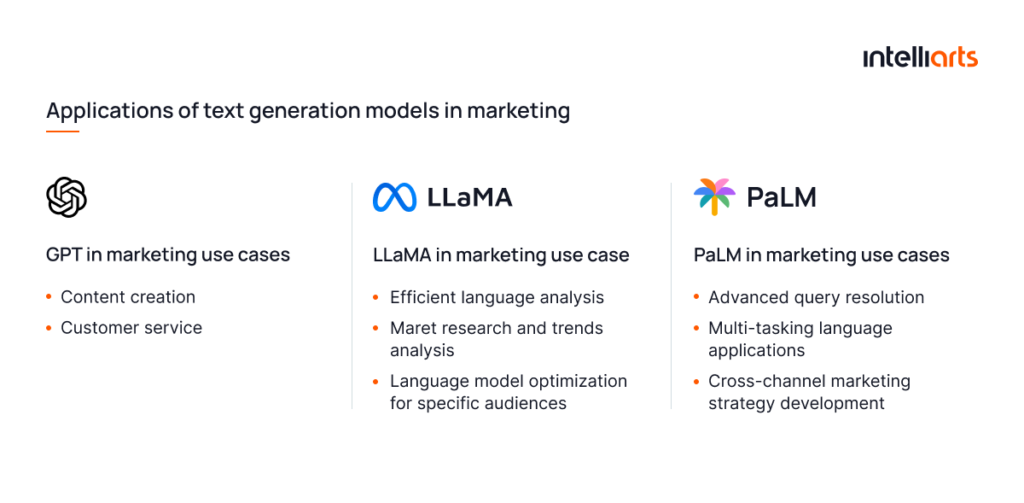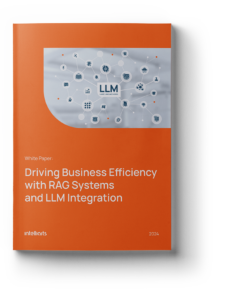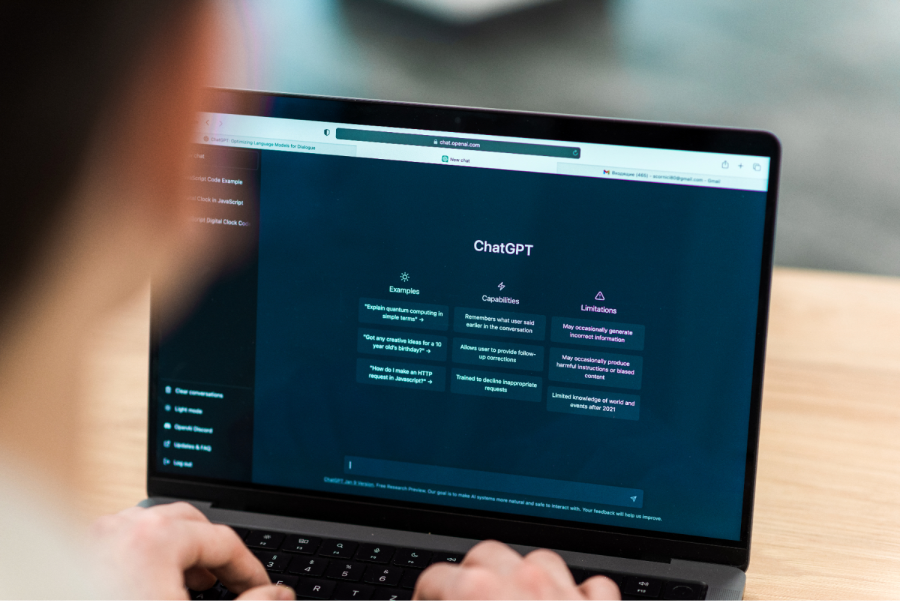The market size in the Generative AI market is projected to reach $66.62 billion in 2024 and then show an annual growth rate of 20.80%, resulting in a market volume of $207.00 billion by 2030. It means that more and more companies have used Generative AI-driven solutions or started offering products and services on their basis, and this tendency will remain strong for years.
In this post, you’ll delve into the technical differences between GPT, LLaMA, and PaLM text generation models. You’ll also discover their possible applications and review a real-life case of using a text generation model in business.
GPT vs. LLaMA vs. PaLM text generation models: What is the difference?
Let’s get started by giving text generation models a primary definition:
The text generation model is an ML-based solution that automatically creates human-like text based on input data and pre-trained language patterns.
Text generation models primarily operate on the Transformer algorithm, a type of deep learning model that uses mechanisms like self-attention to process and generate language. In the field of NLP and text generation, other algorithms like Recurrent Neural Networks (RNN), Convolutional Neural Networks (CNN), Hidden Markov Models (HMM), etc., can also be used.
A detailed comparison of GPT, LLaMA, and PalM text generation models is shown in the infographic below:
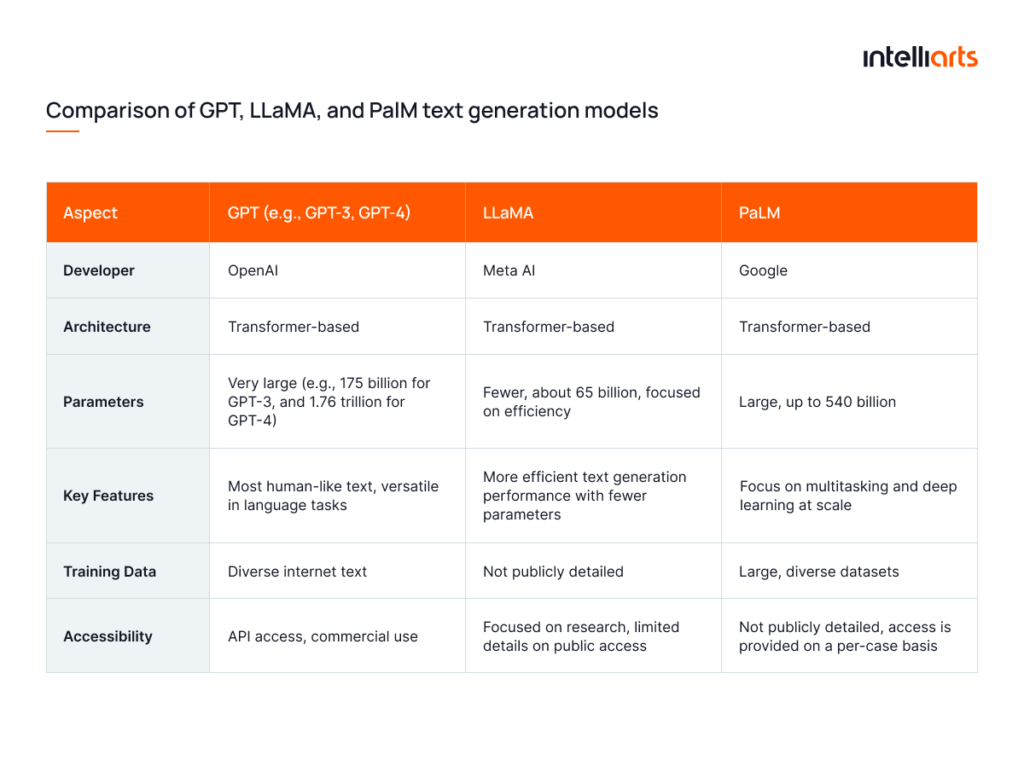
- GPT models are often used in applications like chatbots, content generation, and language translation.
- LLaMA is designed to be a research tool that helps in understanding the workings of large language models and improving them.
- PaLM is designed to demonstrate the capabilities of the Pathways system, which aims to create more general and efficient AI models.
Each model represents a different approach to solving the challenges of natural language processing and generation.
If you’re interested in exploring text generation models, you can also be curious about the role of NLP in various industries.
And if you feel like you need to learn additional tech details on how text generation models, in particular, GPT, work, take a look at the video below:
Applications of text generation models in marketing
GPT, LLaMA, PaLM, and other text generation models are fairly widespread and are gaining more popularity in various domains. Healthcare, manufacturing, education, and e-commerce are only a few of them. Now, let’s focus on two industries where text generation models are used the most, starting with marketing.
Despite LLMs being a relatively new, publicly available technology, generative AI for marketing already offers a broad range of applications. They offer to simplify processes and enhance various aspects of marketing strategies.
#1 GPT in marketing use cases
Here are some of the possible applications of the GPT models in marketing and ways of using ChatGPT for marketing software.
- Content creation
Generation of blogs, social media posts, and other types of long and short-form content.
Example of a basic prompt: “Create a short, engaging social media post to promote a 20% off sale for a new line of running shoes.”
- Customer service
Powering chatbots for 24/7 customer support and answering FAQs.
Example of a basic prompt: “Write a 30-word FAQ about how to choose a running shoe size.”
#2 LLaMA in marketing use cases
Examples of LLaMa use cases in marketing include:
- Efficient language analysis:
Analyzing large sets of customer feedback or academic texts where computational resources are limited.
Example of a basic prompt: “Summarize key themes from customer reviews on our latest product.”
- Market research and trends analysis:
Use case: Analyzing consumer trends, social media sentiments, and market research data to provide actionable insights.
Example of a basic prompt: “Analyze recent social media trends to identify emerging preferences in the eco-friendly products market.”
- Language model optimization for specific audiences:
Fine-tuning the model for specific demographic or geographic audiences to create more targeted and effective marketing messages.
Example of a basic prompt: “Optimize language model to enhance engagement with the 18-25 age group in European markets.”
#3 PaLM in marketing use cases
The ways to exploit PaLM models in marketing are the following:
- Advanced query resolution:
Answering complex, multistep customer queries that require understanding context and subtleties.
Example of a basic prompt: “Explain the differences between various insurance policies for a customer looking for comprehensive coverage.”
- Multi-tasking language applications:
Handling tasks that involve switching between languages or integrating different types of data, like text and numbers.
Example of a basic prompt: “Generate a report that integrates financial data analysis with explanatory text for a quarterly business review.”
- Cross-channel marketing strategy development:
PaLM use cases also include developing comprehensive marketing strategies using marketing analytics software that integrate insights across various channels like social media, email, and web content.
Example of a basic prompt: “Formulate a cross-channel marketing strategy that synergizes social media campaigns with email marketing for a new product launch.”
Applications of text generation models in insurance
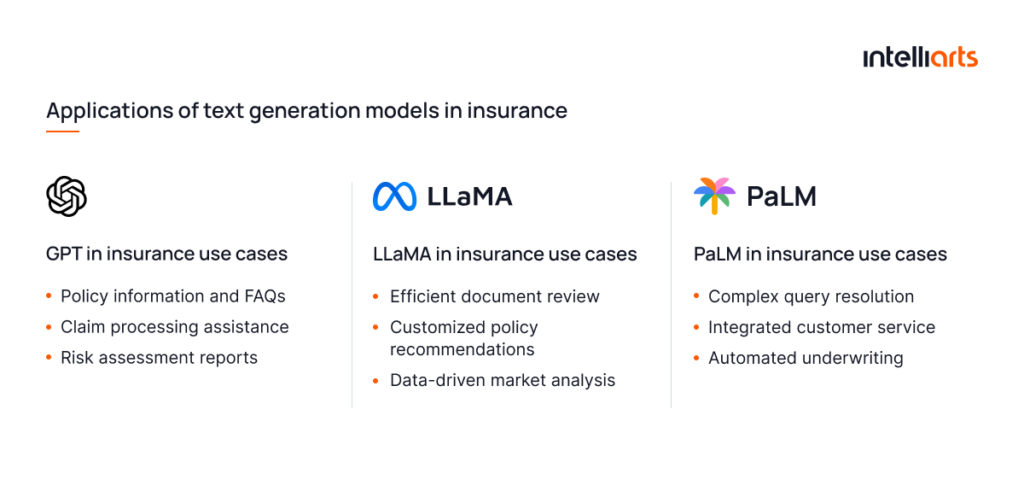
#1 GPT in insurance use cases
Here are some of the possible applications of the GPT models in insurance:
- Policy information and FAQs:
Providing detailed policy information and answering frequently asked questions on insurance websites.
Example of a basic prompt: “Explain the benefits of whole life insurance in a simple, understandable manner for website visitors.”
- Claim processing assistance:
Assisting in the initial stages of claim processing by guiding customers through the required steps and documentation.
Example of a basic prompt: “Create a step-by-step guide for customers on how to file an auto insurance claim.”
- Risk assessment reports:
Generating risk assessment reports based on customer data for underwriters and agents.
Example of a basic prompt: “Generate a risk profile for a potential client interested in high-value property insurance.”
#2 LLaMA in insurance use cases
Examples of LLaMa models usage in insurance include:
- Efficient document review:
Quickly analyzing and summarizing lengthy insurance documents or policy agreements.
Example of basic prompt: “Summarize the key coverage points and exclusions from a 50-page health insurance policy document.”
- Customized policy recommendations:
Offering personalized insurance policy recommendations based on customer profiles and historical data.
Example of a basic prompt: “Provide tailored life insurance policy recommendations for a 40-year-old client with two children.”
- Data-driven market analysis:
Analyzing market trends and customer demographics to aid in developing new insurance products.
Example of a basic prompt: “Analyze demographic shifts in the past decade to identify potential new markets for health insurance products.”
#3 PaLM in insurance use cases
The ways to exploit PaLM models in insurance are the following:
- Complex query resolution:
Handling intricate customer inquiries that involve understanding and explaining complex insurance terms and conditions.
Example of a basic prompt: “Explain the differences between term and universal life insurance to a customer inquiring about long-term financial planning.”
- Integrated customer service:
Providing comprehensive customer service by integrating information from various departments like claims, underwriting, and sales.
Example of a basic prompt: “Create a unified response to a customer who has queries about their premium adjustments, coverage details, and claim status.”
- Automated underwriting:
Utilizing advanced algorithms for automated underwriting helps to assess risks and determine policy premiums more efficiently.
Example of a basic prompt: “Develop an automated underwriting process for evaluating applications for travel insurance, incorporating a range of risk factors.”
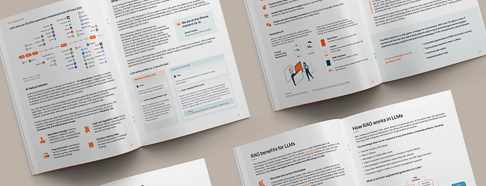
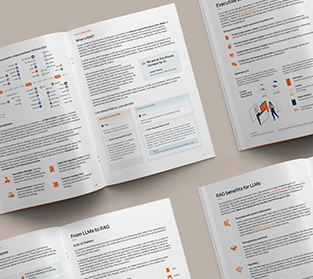
Pro tips from the Intelliarts team to use when working with any AI-based model for the best outcomes:
#1. Be specific. Clearly define the context and the desired outcomes. Be especially cautious when requesting statistics and numbers, as if not provided with a request to include actual statistics only, Generative AI tends to generate abstract numbers.
#2. Include examples. The chances of obtaining the desired outcome on the first attempt increase when you provide a reference. You can always specify changes to make with the reference.
#3. Don’t abuse AI. Always remember that Generative AI lacks human mentality, empathy, and understanding of complex concepts. Try to automate tedious tasks, but review the outcomes and make modifications to sensitive bits of information by yourself.
Read also about insurance machine learning applications.
Intelliarts experience: ChatGPT-based solution for inmate security designation
The Intelliarts’ customer, specializing in criminal matters and sentence mitigation strategies, requested us to validate the product idea for inmate security designation and custody classification through the use of ChatGPT. The solution was intended to help attorneys and lawyers optimize work processes and reduce time spent filling out the Inmate Load and Security Designation Form.
The solution by Intelliarts was the PoC — a machine learning model designed to optimize the efficiency of composing statements. We wrapped it into an application that can help users utilize a prompt effectively by simply uploading filled-out questionnaires and assessment rules for them.
Businesses in the legal industry, as well as lawyers, can use this document data extraction solution powered by OpenAI GPT solution to conduct a quick and effective evaluation of the likelihood of a certain person committing a crime.
You can access additional information on the Chat-GPT-enabled solution for inmate security designation by Intelliarts on our portfolio page.
Final take
The integration of text generation models like GPT, LLaMA, and PaLM in industries such as marketing and insurance represents a significant leap in operational efficiency and customer engagement. These AI-driven solutions offer diverse applications ranging from content creation and customer service to risk assessment and policy customization. So no wonder 97% of business owners believe ChatGPT and other LLMs will benefit their business.
Entrust Intelliarts, an AI and ML service provider with over 24 years of experience, your text generation model idea. We’ll bring industry-leading expertise and substantial experience to your project and help achieve the desired value-adding business outcomes.
FAQ
1. What other industries can use text generation models?
Aside from marketing and insurance, text generation models are used in healthcare, legal, finance, education, entertainment, and customer service for tasks like documentation, content creation, and customer interaction.
2. What are the benefits to companies using text generation models?
The benefits of adopting solutions based on text generation models include increased efficiency, cost reduction, enhanced creativity, improved customer engagement, and the ability to analyze and generate large volumes of text quickly.
3. How is data security ensured when using language models?
Data security using language models is maintained through encryption, access controls, the anonymization of sensitive data, compliance with data protection laws, and regular security audits.

